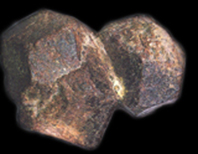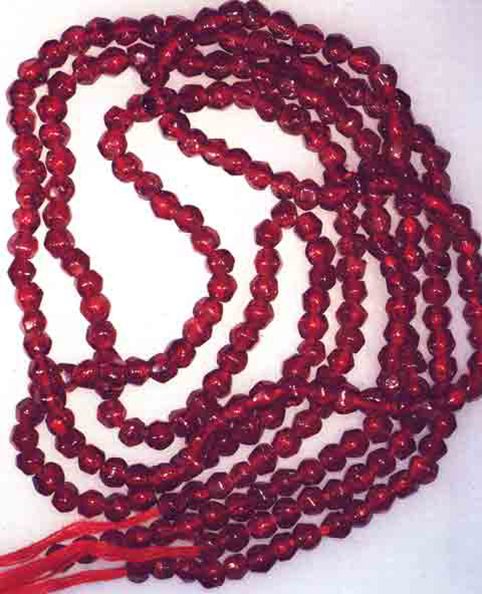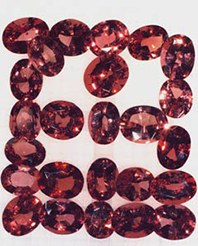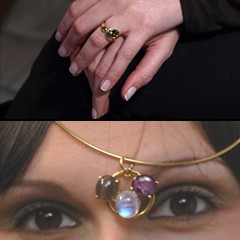
Rhodolite Garnet weighing 18 carats. This is an exceptionally beautiful gemstone, worked masterfully

Rough carnet, not to be cut, of a couple of pounds.
We all have a string of garnets of our grandmother in our drawers. And for those who do not have it anymore, something must be missing. The shape of the grains of those rosaries closely resemble the shape of the garnet crystal, which often presents itself as a perfect rhombododecahedron. And it is possible to find very large garnet crystals but, alas, these specimens are opaque and unfit for gemological purposes.

Necklace made with small garnet.

In Sri Lanka, where they were found and processed, these stones are called “Matara Ruby”. They are great quality rhodolites: the reddest is closer to pyrope, and the clearest is closer to almandine.
As far as we know, artificial garnets for gemological use have not yet been produced in labs yet. If a stone is a garnet, that stone is a natural garnet.
Carbuncle. Red stones that shine like burning coals were called “carbuncles“; that name included rubies, spinels, garnets and zircon. The colors of these stones in many cases resemble each other for real. In the gem-bearing gravels of Sri Lanka they are found, mixed with spinels of the same color, the “Matara Ruby“, which are among the most beautiful garnets in the world.
When garnet is beautiful, it is among the most beautiful stones that are can be! Its bright red color shines clear, without the arrogance of the ruby, without the slightly cheeky tone of the rubellite (red tourmaline), without the imitative characteristics of the spinel (which, in the best quality red, resembling the ruby).
Despite possessing a wide range of red tones, they are always personal colors, with a cheerful and captivating brilliance.

Lot of rhodolite garnets with a modern cut, performed industrially. All stones have the same cut, executed with a certain rigor.

Lot of rhodolite garnets with native cut. Even in large batches it is impossible to find two stones cut in the same manner and with the same color.
Even in the best quality, it keeps an affordable cost. The “carbuncles“, and garnets with them, are among the most tradition-associated stones. They are found almost anywhere, and they have never cost too much. Many beneficial properties have been given to them, healing and propitiatory. For some, especially the clear and bright pieces, they are so nice and beautiful, that their possession must bring serenity and joy. By contrast, an overproduction of very little value objects, which have utilized the lowest materials, without transparency, and any features of value, have, in the past, discredited this stone that instead deserves attention, especially for the clearest samples, which are truly beautiful.
A tip: if you have some items at home with garnet, which belonged to a relative or some ancestor, hold on to it with great care. Apart from the intrinsic value, which can also be modest, they are stones that are able to “get charged” with memories, and their nearness is pleasant.
SPECIFICATIONS
GROUP OF GARNETS.
CRYSTALLIZATION: monometric system.
CHEMICAL COMPOSITION: silicates of various elements, divalent and trivalent. Because of this, its physical and chemical constants are not very ‘constant’, and they vary greatly depending on the variety in question.
CHEMICAL FORMULA: R “3R” ‘2 (SiO4) 3 (R “= Ca, Mg, Fe”, Mn; R “‘ = Al, Fe” ‘, Cr, Ti)
HARDNESS: 6.5-7.5.
SPECIFIC WEIGHT: 3:30 to 4:30.
REFRACTION: monorifrangent, from 1,705 to 1,900.
GEMOLOGICAL VARIETIES: GROSSULAR (the orange variety is called “Essonite”) – PYROPE (intense pure red) – RHODOLITE (intermediate between pyrope and almandine, a bright red color with more clear nuances) – ALMANDINE (red-pink -violet) – ANDRADITE – (in the “Demantoid” variety, it is a pretty green, while in the “Melanite” variety it is black) – UVAROVITE (very dark green) -SPESSARTITE (honey yellow). There are many other names; it could be said that every field has its characteristics so different from the other, and as such deserves hundreds of different names!
FIELDS: It is often associated with other minerals such as topaz, tourmaline, spinel, zircon, beryl, etc.
COLOUR: Unless otherwise specified, the color of garnet is red. The best varieties, must have, as always, the following requirements: bold color, excellent transparency, brilliance which sends rays of light in all shades of the base color of the stone, absence of flickering, but presence of games of light and flashes of brilliance in any position; softness and velvet in color, very good general cleanliness and cutting performed to emphasize the qualities of the gem. Unfortunately, since garnets are generally cheap stones, often, processing leaves much to be desired, and this is a real shame.
SIMILAR STONES: All red stones resemble each other, needless to say. Red Garnet has a softness and a special grace, without the majesty of the Ruby, or the arrogance of the Rubellite (red tourmaline), or the wisdom of the Spinel.



















